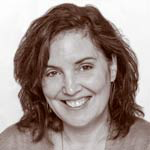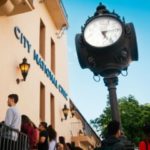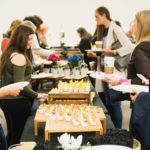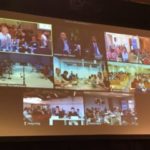In many cases, bigger isn’t always better: cars, personal technology, portion size — and, increasingly, cities. Walkability, value, and friendliness can be strong drivers for why planners choose certain destinations over others for meetings. And more and more, they’re asking questions about a destination’s local expertise and knowledge base. If a city can hit on all of those cylinders, it can emerge as a meetings-business champion.
Below, Convene profiles five modestly sized cities — three in the United States, one in Australia, and one in Europe — that are harnessing their local knowledge economies to lure some surprising meetings. They fall across the spectrum. At least one is in the early stages of mapping its strengths, while another has deftly partnered with its local academic community to create meetings for its convention center.
One thing unites all five destinations: They’re smart about their smarts.

OMAHA, NE
Welcome to the Silicon Prairie
With a half-million residents and a reputation for companies that skew more conservative than cutting-edge, Omaha, Nebraska, would seem to occupy its own low-key, tried-and-true business niche. For Jeff Slobotski and Dusty Davidson, however, the region’s flourishing startup culture was a story that needed telling, which is why, in 2008, they founded an online publication called Silicon Prairie News (SPN) — taking its name from a tech-friendly area that includes Nebraska, Iowa, Kansas, and Missouri.
“It’s true of Omaha, but also the rest of the Midwest, that we tend to get really heads-down and focused on our work, so we’re not as PR- or marketing-driven as some of the other areas around the country,” said Caleb Ulffers, who joined SPN as a speaker manager in 2013. “The founders wanted to write stories and get people really excited about what’s going on in the Silicon Prairie.”
Part of SPN’s model involved live events, as well as the idea for a seminal annual conference that would connect Midwest entrepreneurs with innovative ideas and each other. “[SPN] was like, ‘What better way to [tell the story] than a conference? Let’s call it Big Omaha,’” Ulffers said, “because people think of Omaha as not being big, or not being on the map — sort of a fly-over region.”
For the inaugural Big Omaha program in 2009, SPN brought in high-profile speakers such as Gary Vaynerchuk of VaynerMedia, and WordPress cofounder Matt Mullenweg. About 400 attendees showed up. “[The early speakers] kind of grasped the whole of, ‘Wow, there’s something going on in the Midwest that’s awesome, and we want to stay in touch and be a part of it,’” Ulffers said. “We got some really incredible speakers in the early days, and then just kind of built on that — built what we’re really good at, which is hospitality and treating people really well and having a good time.”
From the get-go, Big Omaha was designed around a one-track keynote session, with no exhibitor booths or breakout sessions but an extra-long networking lunch break featuring healthy and imaginative food options. The format was a success. In 2011, The Next Web called Big Omaha “the most important conference you’ve never attended.” In 2010, the conference moved to KANEKO, a downtown Omaha art gallery whose airy, minimalist space fit Big Omaha’s brand perfectly. This year’s conference was held at KANEKO on May 4–6.
Big Omaha’s 650 or so attendees “skew a little bit younger,” Ulffers said, with many between 25 and 36. “We see people from corporations, from small businesses, from startups, to being founders or in marketing, or on the business desk, or sales, or design.” Beyond providing inspiration, Big Omaha — whose 2016 sponsors included Yahoo!, AT&T, and the Greater Omaha Chamber — also serves as a place where startups and investors can connect. BULU Box, a subscription vitamin service based in nearby Lincoln, found its main investor there.
It’s not all serious business, however. “Big Omaha is known for our parties,” Ulffers said, which draw on downtown’s thriving arts and food scenes, and helped the conference become part of the fabric of Omaha and the entire Silicon Prairie. “The Midwest gets a bad rap,” Ulffers said, “but we have super-low unemployment, and as a region we stick together and support each other.”

RICHMOND, VA
Relaxed but Accelerated
Ameeting that culminates in a visit to a particle accelerator might seem unusual — unless, of course, you’re a nuclear physicist, and you’re attending the International Particle Accelerator Conference (IPAC).
It was the proximity of the Thomas Jefferson National Accelerator Facility in Newport News, Virginia — aka Jefferson Lab — that spurred local organizer Andrew Hutton, Ph.D., associate director of Jefferson Lab’s Accelerator Division, to place IPAC15 in Richmond. “The idea that [IPAC] was trying to get delegates to come and visit our facility,” Hutton said, “was absolutely important.”
IPAC rotates among continents, and when Hutton volunteered to organize the next North American event, he was stymied as to what destination might rival recent hosts such as Kyoto, Japan, and Shanghai, China. “I looked at the other places and said, ‘Is there anywhere around here that can compete with Kyoto or Shanghai in terms of large-scale facilities?’” Hutton said. “No, there wasn’t.”
So he defaulted to another set of criteria: He looked for “a smallish place where government and the people in the city are pleased to see you,” and that was reasonably priced, where attendees could walk to the conference center. And the host destination needed to be “sufficiently close to our lab that we could do a visit just after the conference.”
Richmond fulfilled many of those requirements — and so IPAC15 met at the Richmond Convention Center on May 3–8, 2015. “[Richmond] looked upon us as being a major event,” Hutton said, “and therefore went out of their way to make us feel welcome.”
That’s welcome feedback for Kristin McGrath, CDME, vice president of sales and services for Richmond Region Tourism, whose convention-services team worked closely with IPAC to ensure the heavily international attendee base had everything they needed, such as convenient currency exchange. Although Richmond hasn’t necessarily promoted its proximity to Jefferson Lab in the past, the city was thrilled to have IPAC’s 1,250 attendees in town. “A conference of that size becomes a city-wide, and we’re really able to roll out the red carpet,” McGrath said. “It makes a big impact in the destination, and in the restaurants, and with the residents.”
McGrath’s office has been working with the Greater Richmond Partnership, an economic-development group, to identify Richmond’s knowledge bases and align meetings with them. “We’ve done what we can to strengthen our relationship with that office,” McGrath said, “because they’re really tapped into the knowledge economy from an economic-development standpoint, but our office really can speak to Richmond’s sense of place.” The partnership resulted in a recent score: The Industrial Asset Management Council Professional Forum will meet in Richmond next year.
“It’s exciting for me to see that meeting planners are putting more of an emphasis and asking those types of [knowledge] questions on the front end, asking about the types of businesses and industries that a destination has,” McGrath said. “That’s one of the reasons that we’re working so hard to make sure that we have the relationships locally, so that we can leverage the intellectual power that we have here to the benefit of meeting planners who might be interested in taking advantage of it.”
Hutton received positive feedback from his colleagues over IPAC15, but remembers one gesture in particular. A local Starbucks franchise owner posted a physics question on a chalkboard each morning, and offered a free coffee drink to attendees who could answer correctly. “Can you imagine [the owner] did that?” Hutton said. “The thing was up there for the day, and everybody was trying to work it out. What a beautiful thing to do. He got himself a lot of business, but also a lot of goodwill.”
WILMINGTON, NC
Coastal Prowess
The BioMarine conference, created in 2008, bills itself as the only international investment platform dedicated to marine-biology resources. Each year, the program brings together players in marine finance, industry, and technology. Since its inception, it was always held outside North America — until 2015, when Wilmington, North Carolina, was chosen to host BioMarine’s 300-plus attendees.
Why go from Portugal to North Carolina’s eighth-most-populous city? With the Atlantic Ocean on one side and the Cape Fear River on the other, both salt- and fresh-water environments abound near Wilmington — whose unique geography has helped feed marine-related science sectors, including the Marine Bio-Technologies Center of Innovation and nationally known marine programs at local institutions.
“Ours is a very unique ecosystem, because we’re pretty much where the river meets the sea,” said Kim Hufham, president and CEO of the Wilmington and Beaches Convention & Visitors Bureau. “Not all areas have that, and it gives us some additional opportunities with regards to research and ecosystems. Cape Fear Community College, as well as our university, the University of North Carolina Wilmington, both have very strong programs. Cape Fear Community College has a marine-technology program, and UNCW has a Center for Marine Science.”
Those resources, along with North Carolina’s reputation as one of the top three U.S. states for biotechnology, came into play in landing BioMarine 2015, which was held at Cape Fear Community College’s brand-new Union Station conference center on Oct. 12–14. The conference’s opening day was devoted to a biomarine-technology tour of both UNCW CREST Research Park and the UNCW Aquaculture program’s facilities.
BioMarine’s presence in Wilmington could be a harbinger of things to come, according to John W. Sneed II, CHSP, vice president of sales and services for Wilmington and Beaches CVB. “This was an international group, so the international exposure for us has brought a lot of attention to Wilmington in this field,” Sneed said. “We’ve had some conversations with the folks here locally about other events that are interested in looking at us in the future.”
Hufham added: “We feel like it’s kind of a snowball effect, having something of this caliber here.” It doesn’t stop with marine technology and research, either. “We’re working to align with some of the industries, or knowledge-based groups, that we have strengths in,” she said — including aircraft assembly, pharmaceuticals, and financial services.
NUREMBERG, GERMANY
A Mantle for Social Justice
In 1945–46, Courtroom 600 in Nuremberg’s Palace of Justice was the scene of one of the most dramatic trials of the 20th century — for Nazis accused of crimes against humanity during World War II. Seventy years later, the wood-paneled space is both a tourist site and an active courtroom, but also plays an outsized symbolic role in Nuremberg’s reputation as a venue for social-justice-related meetings and events.
Located in the southern state of Bavaria, Nuremberg is home to the Nuremberg International Human Rights Film Festival, UNESCO’s International Nuremberg Human Rights Award Ceremony, and the Nuremberg Moot Court, an annual mock legal proceeding that acquaints students with criminal law. Last July, the city also hosted the annual summer trip and meeting of the California Judges Association (CJA). About 65 attendees viewed Courtroom 600 for the 70th-anniversary year of the trials, then held a one-day program in the iconic courtroom, with keynote speakers including the U.S. ambassador to Germany. CJA also toured the Dachau Concentration Camp Memorial Site and Nuremberg Friedrich-Alexander University.
“[The Palace of Justice] is a huge historical landmark for justice and the legal industry,” said Linda Nuss, regional manager for North America for the German Convention Bureau (GCB). While Nuremberg is also a technology and logistics center in Germany (see “Mapping the Knowledge Economy,” p. 93), it’s social justice that is most closely associated with the medieval city. “The Nuremberg Trials were a foundation for the future of addressing war crimes and crimes against humanity,” Nuss said. “Nuremberg is steeped in that history. Instead of hiding it, they open it up, and focus on education.”
While CJA’s 2015 summer outing had perhaps the most recent direct tie-in to Courtroom 600, the GCB encourages attendees at pretty much any meeting held in Nuremberg to visit the Palace of Justice. “When other meetings come in,” Nuss said, “we always encourage them to visit those sites as well, and educate themselves on that level.”
BRISBANE, AUSTRALIA
Carving Its Own Niche
Brisbane may be among the most laid-back of Australian cities, but it’s also something of a stalwart when it comes to attracting international meetings. Indeed, while hosting a G20 summit at the Brisbane Convention & Exhibition Centre (BCEC) in November 2014 certainly helped raise the destination’s international visibility, Alison Gardiner, director of sales – conventions for the BCEC, says the city had taken a proactive approach to conventions long before then.
“As a slightly smaller city than, say, Sydney, we do need to then be smart about where we focus,” Gardiner said. “Because we do have this very strong knowledge economy in Brisbane, it makes sense for us to align with what the universities are wanting to showcase, and where they’re investing their research funds.”
In 2009, the BCEC — which has its own internationally focused sales team — began taking a more organized approach to tapping the research talent at the city’s three universities. “We wanted to build that into a more formal network,” Gardiner said, “that acknowledged the contributions they were making.” The resulting consortium of scientists, researchers, innovators, and business leaders was dubbed the BCEC Convention Advocates Partnership.
The group systematically examined and either ruled out or decided to chase various sectors. Finance and education, for example, didn’t quite fit with the advocates’ vision or base. Instead, they focused on areas where they already had expertise, hoped to do future research, or saw ascending in coming years. “[Our partners] were giving us a lot of excellent advice,” Gardiner said, “and helping us look at not just which meetings we should go for but which meetings we should not go for — perhaps areas in decline, or perhaps spaces that were changing over time.”
Niche meetings, such as those in tropical medicine and biomechanics, seemed a particularly ideal fit, both research-wise and spatially — the BCEC has distinct areas for both large and intimate meetings. “Sometimes we learn that bigger’s not always best,” Gardner said, “but we always like to have a bit of a spread.”
The 70-member partnership also originated some of their own meetings. With 250 delegates, Immunotherapy@Brisbane 2015 was deemed a success, and the BCEC will host a second conference in 2017. “They see that [meeting] growing to around about 500 or 600, and probably staying steady there as a niche meeting,” Gardiner said. The group also created a conference called Solutions for Drug-Resistant Infections, with the inaugural program scheduled for April 3–5, 2017.
The 71 conferences that the partnership has helped either attract or create for Brisbane have had a combined economic benefit of about $91 million AUD. “The nice thing about our relationship with our scientific community is, of course, we welcome the big ones, but we are principally interested in making sure that we’re going to chase meetings that they want to see here,” Gardiner said. “We’ve always punched above our weight. While we don’t necessarily have the same sort of profile [as] Sydney and Melbourne, for the general man-in-the-street awareness, we do have quite strong recognition within our science communities. It would be fair to say that we’ve really played to those strengths, because as a smaller city, that’s our best strategy to go forward.” .
Mapping the Knowledge Economy
As destinations increasingly draw on their knowledge bases to attract meetings and urban development, they might take a page from Germany’s playbook: Think bigger, and map things out.
Germany doesn’t mess around when it comes to its knowledge economies. For a while now, the country has mapped them out by region in order to attract “like-minded” meetings to certain locales. “We’ve been following this strategy for a few years,” said Linda Nuss, regional manager for North America for the German Convention Bureau. “It’s something we continually focus on, the regional expertise that Germany offers. We’re a small country, but a highly specialized one, and we like to focus on the six key industries we have right now.”
To promote that expertise, Germany identified areas where it helps set the global agenda: technology and innovation; energy and the environment; transport and logistics; medicine and health care; chemicals and pharmaceuticals; and financial services. While Germany’s major cities have a concentration of knowledge and business in all six sectors, each also excels in at least one. Frankfurt is Germany’s financial epicenter, for example, consistently attracting programs such as Euro Finance Week, held each November. Likewise, the Frankfurt School of Finance and Management organizes its own roster of finance-related gatherings.
Similarly, with 150-plus medical institutes and clinics, Leipzig is a nexus for medical meetings, some of which are pushing the envelope with innovative technology — such as the Leipzig Interventional Course (LINC), a congress of vascular surgeons that has an annual in-person meeting in Leipzig but broadcasts its program globally. LINC’s roughly 5,000 attendees come from 70 countries. And the format has legs: There are now LINC events across the world, including in Las Vegas and New York City later this year.
“What’s interesting about LINC is there are no walls. It’s a free-flowing event. People can come and go to the various lectures as they please,” Nuss said. “They have live procedures and operations on more than 90 screens. It’s kind of like a Q&A live interaction with the surgeons. With a medical conference, that’s an amazing perk to have.”







